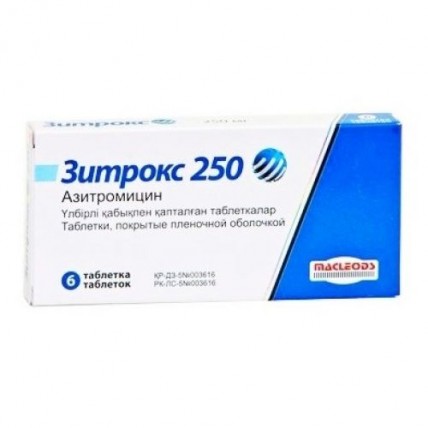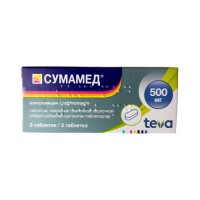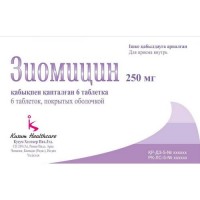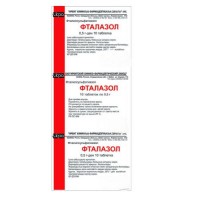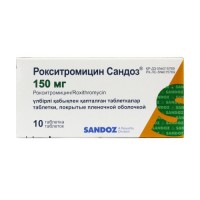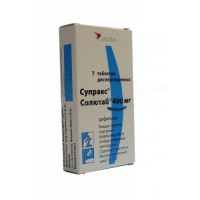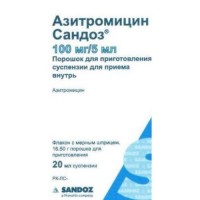Zitroks 6's 250 mg film-coated tablets
- $14.20
The instruction
for medical use
of ZITROKS 250 medicine
of ZITROKS 500
the Trade name
of Zitroks of 250
Zitroks 500
International unlicensed
names Azithromycin Dosage Form
of the Tablet, film coated 250 mg and 500 mg
Structure
One tablet contains
active agent - azithromycin a dihydrate 262.02 or 524.04
is equivalent to azithromycin of 250 mg or 500 mg,
excipients: calcium hydrophosphate anhydrous, starch prezhelatinirovanny, krospovidon, polysorbate 80, silicon dioxide colloidal anhydrous, cellulose microcrystalline, sodium the lauryl sulfate, talc purified magnesium stearate, 2 propyl alcohol,
structure of a cover: hydroksipropilmetiltsellyuloza of E-5, titan E171 dioxide, polyethyleneglycol 400, methylene dichloride.
The description
of the Tablet of a capsulovidny form, with a biconvex surface, film coated white color, smooth on both sides (for a dosage of 250 mg).
Tablets of a capsulovidny form, with a biconvex surface, film coated white color, smooth on both sides, with risky on one party (for a dosage of 500 mg).
Pharmacotherapeutic group
Antimicrobial drugs for system use. Macroleads, linkozamida and streptogramina. Macroleads. Azithromycin.
The ATX J01FA10 code
the Pharmacological
Pharmacokinetics At properties intake drug is well soaked up and quickly distributed on all organism. Gets in cells, including phagocytes which migrate in the inflammation center, promoting creation of therapeutic concentration of drug in the place of an infection. In 12-72 hours in the place of inflammation high therapeutic concentrations (1-9 mg/kg) exceeding the minimum overwhelming concentration for contagiums are created. Possesses long elimination half-life and it is slowly brought out of fabrics (on average 60–76 hours). The specified properties define a possibility of single dose of drug in day and the short mode of dosing (3 days) providing 7 - a 10-day course of treatment. It is metabolized generally in a liver, metabolites are not active. Gets through a placenta. Drug generally with bile in not changed look is emitted, a small part is removed by kidneys.
The pharmacodynamics
of Zitroks possesses a wide range of antimicrobic action. Communicating with 50S-cybjedinitsey ribosomes, suppresses biosynthesis of proteins of a microorganism. In high concentrations renders bactericidal effect. It is active concerning a number of gram-positive bacteria: Streptococcus pneumoniae, S. pyogenes, S. agalactiae, S. viridans, streptococci of group C, F and G, Staphylococcus aureus, S. epidermidis. He has effect on the gram-positive bacteria resistant to erythromycin. It is effective concerning gram-negative microorganisms: Haemophilus influenzae, H. parainfluenzae and N. of ducreyi, Moraxella catarrhalis, Bordetella pertussis and V. of parapertussis, Neisseria gonorrhoeae and N. meningitidis, Brucella melitensis, Helicobacter pylori, Gardnerella vaginalis. It is active concerning Campylobacter jejuni, some anaerobic microorganisms: Clostridium perfringens and also Micobacteria avium complex, Besides, is effective concerning intracellular and other microorganisms, including: Legionella pneumophila, Chlamydia trachomatis and S. of pneumoniae, Mycoplasma pneumoniae, Ureaplasma urealyticum, Listeria monocitogenes, Borrelia burgdorferi, Treponema pallidum.
Indications
- upper respiratory tract infections (bacterial pharyngitis / tonsillitis, sinusitis, average otitis)
- lower respiratory tract infections (bacterial bronchitis, interstitial and alveolar pneumonia, exacerbation of chronic bronchitis)
- infections of skin and soft tissues (the chronic migrating erythema - an initial stage of a disease of Lyme, an ugly face, impetigo, secondary pyodermatoses)
- infections, sexually transmitted (an urethritis, a cervicitis)
- the diseases of a stomach and a 12-perstny gut associated with Helicobacter pylori.
Route of administration and doses
Inside, 1 time a day, for an hour to food or in two hours after a meal.
Tablets should be swallowed entirely.
In an infection of upper and lower airways, skin and soft tissues (except for the chronic migrating erythema): adult: 500 mg once a day within 3 days (course dose of 1.5 g),
to children are more senior than 6 years: at the rate of 10 mg/kg of body weight once a day within 3 days (course dose of 30 mg/kg).
At the chronic migrating erythema: adult: 1 time a day within 5 days: the 1st day – 1.0 g (2 tablets on 500 mg), then from the 2nd to 5 day - on 500 mg (course dose of 3.0 g),
children is more senior than 6 years: in the 1st day - in a dose of 20 mg/kg of body weight and then from 2 to the 5th day - daily in a dose of 10 mg/kg of body weight (course dose of 30 mg/kg).
In the diseases of a stomach and a 12-perstny gut associated with Helicobacter pylori:
1 g (2 tablets on 500 mg) in day within 3 days in combination with anti-secretory means and other medicines.
In infections, sexually transmitted: an uncomplicated urethritis / cervicitis – 1 g once complicated it is long the proceeding urethritis/cervicitis caused by Chlamydia trachomatis - on 1 g three times for a course at an interval of 7 days (in 1, 7 and 14 day). Course dose of 3 g.
Side effects
Often (& gt, 1/100, & lt, 1/10)
- nausea, vomiting, diarrhea, an abdominal pain
not often (& gt, 1/1000, & lt, 1/100)
- a liquid chair, a meteorism, a digestive disturbance, loss of appetite
Seldom (& gt, 1/1000, & lt, 1/100)
- a headache, dizziness, drowsiness, spasms, a dysgeusia
- a tromotsitopeniya
- aggression, excitement, concern, nervousness, insomnia
- paresthesias and an asthenia
- a hearing disorder, deafness and sonitus
- tachycardia, arrhythmia with ventricular tachycardia, lengthening of an interval of QT
- discoloration of language, a constipation, pseudomembranous colitis
- tranzitorny rise in level of aminotransferases of a liver, bilirubin,
cholestatic jaundice, hepatitis
- reactions of hypersensitivity (reddening, skin rash, an itching, a small tortoiseshell,
a Quincke's disease, photosensitivity), a multiformny erythema,
Stephen-Johnson's syndrome and a toxic epidermal necrolysis,
- an arthralgia
Very seldom (& gt, 1/10000, & lt, 1/1000)
- interstitial nephrite, an acute renal failure
- fatigue, convulsions
- change of taste and sense of smell
- an arthralgia
- vaginita, candidiasis, superinfections
- an acute anaphylaxis including hypostasis (in rare instances leading to death)
Contraindications
- hypersensitivity to azithromycin, erythromycin or other antibiotics of group of macroleads
- a concomitant use of drugs of an ergot
- the I trimester and the period of a lactation
- heavy abnormal liver functions and kidneys
- arrhythmia
- children's age up to 6 years (for a dose of 500 mg – 12 years)
Medicinal interactions
the Antiacid means (containing aluminum, magnesium, ethanol) and meal reduce Zitroks's absorption therefore the drug should be taken, at least, in one hour prior to or in two hours after intake of these drugs and food.
At a concomitant use with Zitroks the plasma concentration of theophylline increase.
At a concomitant use with Zitroks the anticoagulating effect of warfarin amplifies, in need of joint reception it is recommended to carry out careful control of a prothrombin time.
Plasma concentration of digoxin and Cycloserinum increase at a concomitant use with Zitroks.
At a concomitant use with carbamazepine the manifestation of its toxic action is possible.
At joint reception with Zitroks the plasma levels of a triazolam increase that can lead to toxic reactions.
At a concomitant use of Zitroks with ergotamine and dihydroergotamine the manifestation of their toxic action (vasospasm, a dizesteziya) is possible.
Linkozamina weaken, and tetracycline and chloramphenicol enhance Zitroks's efficiency.
Zitroks pharmaceutical it is incompatible with heparin.
- the passed dose it is necessary to accept special instructions in case of the admission of reception of one dose of drug as soon as possible, and the subsequent - with breaks at 24 o'clock.
In slight and moderate abnormal liver functions and kidneys and also the patient, it is necessary to appoint drug with care with cardiovascular pathology. Administration of drug can provoke an arrhythmia attack (ventricular arrhythmias and lengthening of an interval of QT are possible).
Pregnancy
Use at pregnancy II and III trimester is possible only in cases when the expected advantage for mother considerably exceeds possible risk for a fruit.
The feature of influence of medicine on ability to run transport or potentially dangerous mechanisms
during treatment needs to be careful during the driving of motor transport and occupation other potentially dangerous types of activity demanding the increased concentration of attention and speed of psychomotor reactions.
Overdose
Symptoms: nausea, temporary hearing loss, vomiting, diarrhea.
Treatment: gastric lavage, prescribing of activated carbon, symptomatic therapy.
A form of release and packing
On 6 tablets (for a dosage of 250 mg) or on 3 tablets (for a dosage of 500 mg) in blister strip packaging from aluminum foil.
On 1 blister strip packaging together with the instruction for medical use in the state and Russian languages put in a cardboard pack.
To Store storage conditions in the dry place protected from light at a temperature not over 250C.
To store out of children's reach!
2 years
not to apply a period of storage after an expiration date.
Prescription status
According to the prescription
the Name and the country
of the Macleods Pharmaceuticals Limited 304, Atlanta Arcade, Marol Church Road, Andheri (East), Mumbai manufacturing organization – 400,059, India.
The name and the country of the owner of the registration certificate
of Macleods Pharmaceuticals Limited, India
the Name and the country of the organization of the packer
of Macleods Pharmaceuticals Limited, India
the Address of the organization accepting in the territory of the Republic of Kazakhstan claims from consumers on quality of products
Representation of "Macleods Pharmaceuticals Limited" in RK
Almaty, Makatayev St. 117, Body "B", the 4th floor, office
37 Ph./fax. +7 727 3562832
E-mail:
To Develop vijay9376@yahoo.com
for medical use
of ZITROKS 250 medicine
of ZITROKS 500
the Trade name
of Zitroks of 250
Zitroks 500
International unlicensed
names Azithromycin Dosage Form
of the Tablet, film coated 250 mg and 500 mg
Structure
One tablet contains
active agent - azithromycin a dihydrate 262.02 or 524.04
is equivalent to azithromycin of 250 mg or 500 mg,
excipients: calcium hydrophosphate anhydrous, starch prezhelatinirovanny, krospovidon, polysorbate 80, silicon dioxide colloidal anhydrous, cellulose microcrystalline, sodium the lauryl sulfate, talc purified magnesium stearate, 2 propyl alcohol,
structure of a cover: hydroksipropilmetiltsellyuloza of E-5, titan E171 dioxide, polyethyleneglycol 400, methylene dichloride.
The description
of the Tablet of a capsulovidny form, with a biconvex surface, film coated white color, smooth on both sides (for a dosage of 250 mg).
Tablets of a capsulovidny form, with a biconvex surface, film coated white color, smooth on both sides, with risky on one party (for a dosage of 500 mg).
Pharmacotherapeutic group
Antimicrobial drugs for system use. Macroleads, linkozamida and streptogramina. Macroleads. Azithromycin.
The ATX J01FA10 code
the Pharmacological
Pharmacokinetics At properties intake drug is well soaked up and quickly distributed on all organism. Gets in cells, including phagocytes which migrate in the inflammation center, promoting creation of therapeutic concentration of drug in the place of an infection. In 12-72 hours in the place of inflammation high therapeutic concentrations (1-9 mg/kg) exceeding the minimum overwhelming concentration for contagiums are created. Possesses long elimination half-life and it is slowly brought out of fabrics (on average 60–76 hours). The specified properties define a possibility of single dose of drug in day and the short mode of dosing (3 days) providing 7 - a 10-day course of treatment. It is metabolized generally in a liver, metabolites are not active. Gets through a placenta. Drug generally with bile in not changed look is emitted, a small part is removed by kidneys.
The pharmacodynamics
of Zitroks possesses a wide range of antimicrobic action. Communicating with 50S-cybjedinitsey ribosomes, suppresses biosynthesis of proteins of a microorganism. In high concentrations renders bactericidal effect. It is active concerning a number of gram-positive bacteria: Streptococcus pneumoniae, S. pyogenes, S. agalactiae, S. viridans, streptococci of group C, F and G, Staphylococcus aureus, S. epidermidis. He has effect on the gram-positive bacteria resistant to erythromycin. It is effective concerning gram-negative microorganisms: Haemophilus influenzae, H. parainfluenzae and N. of ducreyi, Moraxella catarrhalis, Bordetella pertussis and V. of parapertussis, Neisseria gonorrhoeae and N. meningitidis, Brucella melitensis, Helicobacter pylori, Gardnerella vaginalis. It is active concerning Campylobacter jejuni, some anaerobic microorganisms: Clostridium perfringens and also Micobacteria avium complex, Besides, is effective concerning intracellular and other microorganisms, including: Legionella pneumophila, Chlamydia trachomatis and S. of pneumoniae, Mycoplasma pneumoniae, Ureaplasma urealyticum, Listeria monocitogenes, Borrelia burgdorferi, Treponema pallidum.
Indications
- upper respiratory tract infections (bacterial pharyngitis / tonsillitis, sinusitis, average otitis)
- lower respiratory tract infections (bacterial bronchitis, interstitial and alveolar pneumonia, exacerbation of chronic bronchitis)
- infections of skin and soft tissues (the chronic migrating erythema - an initial stage of a disease of Lyme, an ugly face, impetigo, secondary pyodermatoses)
- infections, sexually transmitted (an urethritis, a cervicitis)
- the diseases of a stomach and a 12-perstny gut associated with Helicobacter pylori.
Route of administration and doses
Inside, 1 time a day, for an hour to food or in two hours after a meal.
Tablets should be swallowed entirely.
In an infection of upper and lower airways, skin and soft tissues (except for the chronic migrating erythema): adult: 500 mg once a day within 3 days (course dose of 1.5 g),
to children are more senior than 6 years: at the rate of 10 mg/kg of body weight once a day within 3 days (course dose of 30 mg/kg).
At the chronic migrating erythema: adult: 1 time a day within 5 days: the 1st day – 1.0 g (2 tablets on 500 mg), then from the 2nd to 5 day - on 500 mg (course dose of 3.0 g),
children is more senior than 6 years: in the 1st day - in a dose of 20 mg/kg of body weight and then from 2 to the 5th day - daily in a dose of 10 mg/kg of body weight (course dose of 30 mg/kg).
In the diseases of a stomach and a 12-perstny gut associated with Helicobacter pylori:
1 g (2 tablets on 500 mg) in day within 3 days in combination with anti-secretory means and other medicines.
In infections, sexually transmitted: an uncomplicated urethritis / cervicitis – 1 g once complicated it is long the proceeding urethritis/cervicitis caused by Chlamydia trachomatis - on 1 g three times for a course at an interval of 7 days (in 1, 7 and 14 day). Course dose of 3 g.
Side effects
Often (& gt, 1/100, & lt, 1/10)
- nausea, vomiting, diarrhea, an abdominal pain
not often (& gt, 1/1000, & lt, 1/100)
- a liquid chair, a meteorism, a digestive disturbance, loss of appetite
Seldom (& gt, 1/1000, & lt, 1/100)
- a headache, dizziness, drowsiness, spasms, a dysgeusia
- a tromotsitopeniya
- aggression, excitement, concern, nervousness, insomnia
- paresthesias and an asthenia
- a hearing disorder, deafness and sonitus
- tachycardia, arrhythmia with ventricular tachycardia, lengthening of an interval of QT
- discoloration of language, a constipation, pseudomembranous colitis
- tranzitorny rise in level of aminotransferases of a liver, bilirubin,
cholestatic jaundice, hepatitis
- reactions of hypersensitivity (reddening, skin rash, an itching, a small tortoiseshell,
a Quincke's disease, photosensitivity), a multiformny erythema,
Stephen-Johnson's syndrome and a toxic epidermal necrolysis,
- an arthralgia
Very seldom (& gt, 1/10000, & lt, 1/1000)
- interstitial nephrite, an acute renal failure
- fatigue, convulsions
- change of taste and sense of smell
- an arthralgia
- vaginita, candidiasis, superinfections
- an acute anaphylaxis including hypostasis (in rare instances leading to death)
Contraindications
- hypersensitivity to azithromycin, erythromycin or other antibiotics of group of macroleads
- a concomitant use of drugs of an ergot
- the I trimester and the period of a lactation
- heavy abnormal liver functions and kidneys
- arrhythmia
- children's age up to 6 years (for a dose of 500 mg – 12 years)
Medicinal interactions
the Antiacid means (containing aluminum, magnesium, ethanol) and meal reduce Zitroks's absorption therefore the drug should be taken, at least, in one hour prior to or in two hours after intake of these drugs and food.
At a concomitant use with Zitroks the plasma concentration of theophylline increase.
At a concomitant use with Zitroks the anticoagulating effect of warfarin amplifies, in need of joint reception it is recommended to carry out careful control of a prothrombin time.
Plasma concentration of digoxin and Cycloserinum increase at a concomitant use with Zitroks.
At a concomitant use with carbamazepine the manifestation of its toxic action is possible.
At joint reception with Zitroks the plasma levels of a triazolam increase that can lead to toxic reactions.
At a concomitant use of Zitroks with ergotamine and dihydroergotamine the manifestation of their toxic action (vasospasm, a dizesteziya) is possible.
Linkozamina weaken, and tetracycline and chloramphenicol enhance Zitroks's efficiency.
Zitroks pharmaceutical it is incompatible with heparin.
- the passed dose it is necessary to accept special instructions in case of the admission of reception of one dose of drug as soon as possible, and the subsequent - with breaks at 24 o'clock.
In slight and moderate abnormal liver functions and kidneys and also the patient, it is necessary to appoint drug with care with cardiovascular pathology. Administration of drug can provoke an arrhythmia attack (ventricular arrhythmias and lengthening of an interval of QT are possible).
Pregnancy
Use at pregnancy II and III trimester is possible only in cases when the expected advantage for mother considerably exceeds possible risk for a fruit.
The feature of influence of medicine on ability to run transport or potentially dangerous mechanisms
during treatment needs to be careful during the driving of motor transport and occupation other potentially dangerous types of activity demanding the increased concentration of attention and speed of psychomotor reactions.
Overdose
Symptoms: nausea, temporary hearing loss, vomiting, diarrhea.
Treatment: gastric lavage, prescribing of activated carbon, symptomatic therapy.
A form of release and packing
On 6 tablets (for a dosage of 250 mg) or on 3 tablets (for a dosage of 500 mg) in blister strip packaging from aluminum foil.
On 1 blister strip packaging together with the instruction for medical use in the state and Russian languages put in a cardboard pack.
To Store storage conditions in the dry place protected from light at a temperature not over 250C.
To store out of children's reach!
2 years
not to apply a period of storage after an expiration date.
Prescription status
According to the prescription
the Name and the country
of the Macleods Pharmaceuticals Limited 304, Atlanta Arcade, Marol Church Road, Andheri (East), Mumbai manufacturing organization – 400,059, India.
The name and the country of the owner of the registration certificate
of Macleods Pharmaceuticals Limited, India
the Name and the country of the organization of the packer
of Macleods Pharmaceuticals Limited, India
the Address of the organization accepting in the territory of the Republic of Kazakhstan claims from consumers on quality of products
Representation of "Macleods Pharmaceuticals Limited" in RK
Almaty, Makatayev St. 117, Body "B", the 4th floor, office
37 Ph./fax. +7 727 3562832
E-mail:
To Develop vijay9376@yahoo.com
